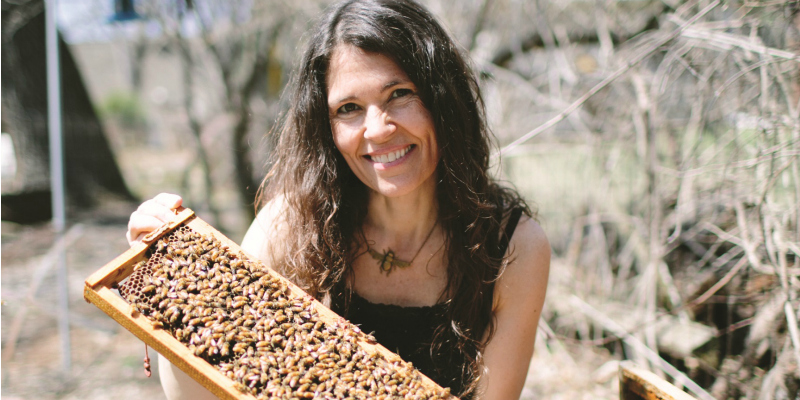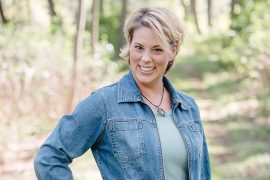Heather Swan Finds Inspiration for Saving The Honeybee
By Julia Richards| Photographed by Hillary Schave
When Heather Swan’s dad took her to a beekeeper friend’s honey harvest she knew she wanted to take part in beekeeping. “We went into a room where he had opened up all of the frames and was harvesting honey and the smell of honey and wax and seeing these little honeybees floating around…I just thought beekeepers are magical, honeybees are magical.”
Now Swan hopes to inspire that sense of wonder and affection for the honeybee in readers of her book, “Where Honeybees Thrive: Stories from the Field.” The work, published by Pennsylvania State University Press, just won the Sigurd F. Olson Nature Writing Award. This annual award, named for a prominent nature writer, goes to a book that “best captures the spirit of the human relationship with the natural world.”
In the book, Swan, a UW-Madison lecturer in environmental literature and writing, presents the work of people in various fields seeking to safeguard the imperiled honeybee. Honeybee populations have dropped in recent years with pesticides, mites, disease and habitat loss all pointed to as culprits. Swan became a beekeeper herself around 2007, right at the time that colony collapse disorder, in which a majority of worker bees mysteriously abandon their hive, was in the news. Over more than five years she researched the plight of the honeybee, as well as the people working on the issue—everyone from entomologists to farmers large and small. She uncovered a variety of strategies for saving this important pollinator, from planting wildflower borders around farm fields to reducing pesticide use. “I realized pretty quickly that it wasn’t just one problem, but a whole mosaic of problems that needed a whole mosaic of answers,” she says.
One of the places Swan turns for answers is the world of art. The daughter of two artists, she grew up in studios and galleries. At the end of each chapter she includes a section featuring an artist whose work involves the honeybee. “The art is in no way just decoration in the book for me,” Swan says. “It’s another way of understanding the nuances of these problems that we’re facing right now.” While emphasizing that scientific study is vitally important, Swan sees the arts as being able to approach audiences in a different way.
“Certain ideas are communicated really well in art and poetry that aren’t easily communicated in statistics or a report,” she says.
Sainath Suryanarayanan, assistant scientist in the UW Population Health Institute, also sees value in artists’ unique perspectives. “Scientists have a lot to learn from artists and poets and fiction writers because these creative people—scientists are also creative people—are able to show through their work another possible set of worlds,” he says.
Swan features Suryanarayanan in her book for his work on new research methods to study honeybee health. After his involvement in traditional research studies on the toxicity of certain chemicals to honeybees, he was bothered not only by the number of bees killed in the process, but also by the failure of the experiment to reproduce the complex factors honeybees face, such as exposure to low doses of multiple chemicals over time. “Sainath’s uncommon compassion for insects, his unusual connection with them, motivated his innovations in experimental design,” Swan writes in her book.
For Swan, art is a way to make those compassion-inspiring connections. “Sometimes people do need to be moved by something; they need wonder and beauty,” she says. If Swan can inspire people to take steps that benefit bees, she reasons, they’ll also benefit all the living things that need the same basics for health. “If we think about what’s good for a honeybee, it’s good for a frog, it’s good for a bird, it’s good for a child.”
Check out Linger on P. 60 in the June issue for a closeup image Heather Swan took of her hives.




